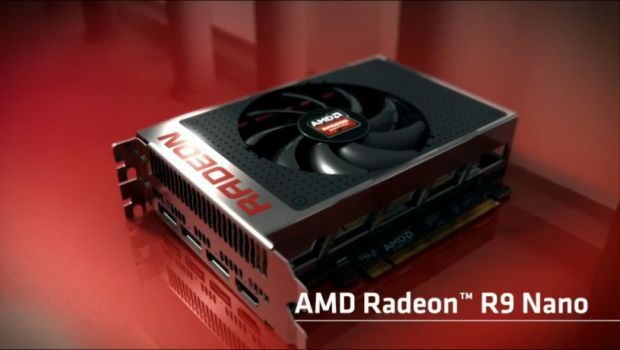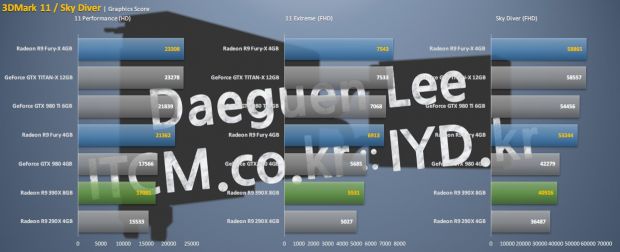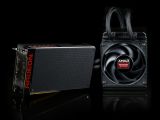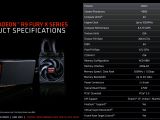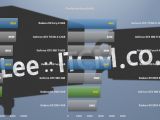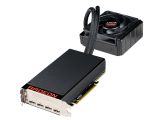The long-awaited AMD E3 conference has come and gone, but left a serious mark on the industry as the company launched the new groundbreaking Fiji GPU-based series of graphics cards ready to take on the competition.
Also with the new series, AMD has announced the prices for some of the new Fury series. The Fury X flagship will ship to US stores at about $649 while the US Fury air-cooled version will come at $549. The pricings for the Nano version, however, have not been revealed. The two top models are supposed to come on June 24 and July 14, respectively, and Nano will also follow shortly.
The flagship, however, is as it was foretold, incredibly powerful. Not only does it come with HBM tech, although the size is not that impressive at the moment, but is has probably the most powerful GPU on the market. The Fiji GPU which measures around 560mm2 is the biggest chip AMD has ever produced. Inside it, there are 8.9 billion transistors and 64 Compute Units, each featuring 64 stream processors. After running the numbers, we get a total of 4096 stream cores, 128 raster operation units and 256 texture mapping units.
Increased memory size in a smaller area
As the new card is meant to push the 4K boundaries forward, the Fiji GPU pumps out a really vast 8.6 TFlops of compute performance (FP32), which very is impressive. Yet, the HBM tech is what this launch it was all about. Although, as I previously mentioned, the size is not really impressive right now and will surely grow in the near future, it's the tech that people are really interested in. Packed alongside the GPU die, the GPU and HBM are actually allotted space on an interposer die which measures around 1000mm2.
While the chip overall has a much bigger size than anything produced before, the HBM saves, in fact, a lot more room on the PCB that the previously GDDR5 chips would have occupied. This has led to the PCB overall design to be much smaller than previous cards, and way more powerful. The card comes packed with 4 GB of HBM memory that operates along a 4096-bit wide bus interface, clocked at 500 MHz and pumps out 512 GB/s bandwidth. The core clock is maintained at 1050 MHz for reference designs and leads to a total of 8.6 TFlops of FP32 compute performance.
And you can't give proper meaning to HBM technology if you don't manage to squeeze more performance per watt that the older cards. The new Fiji GPU now pumps around 28.7 GFlops/W versus 19.4 GFlops/W of the older 200 series. You can check AMD Radeon's R9 Fury X Series specs right here.
Now, putting aside the Fury X we can look at its smaller, but no less powerful, brothers: the AMD Radeon R9 Fury AC and the R9 Nano.
The Radeon Fury AC comes with a 584 stream process, 56 ROPs and has clock speeds of 1.0 GHz core and 4 GB (500 MHz) HBM memory that pumps out 512 Gb/s bandwidth along a 4096-bit wide bus interface. While the Nano is basically a Fiji smaller than the 290X, yet is faster than the Hawaii GPU, being extremely power efficient. Measuring only 15 centimeters and being powered by a single fan, it is meant to bring the Fiji power to Mini-ITX systems.Unofficial benchmarks show AMD stealing Nvidia's flag
Benchmarks at IYD show us how the Nvidia and AMD flagships face each other under 3DMark 11 and 3DMark Fire Strike stress.
Apparently the top winner is, quite predictable, the Fury X, seconded quickly in performance scores by the Titan X and GTX 980 Ti. Nonetheless, the GTX 980Ti is faster than the Fury AC version and the Radeon 390X.
However, the Firestrike benchmark shows that the Fury X will outperform the Titan X in all 4K resolutions until reaching 5K and 8K right where the Titan X inevitably takes the lead. WCCFTech compiled a list of what specs are known so far:| Radeon R9 Fury X2 | Radeon R9 Fury X (Water Cooled) | Radeon R9 Nano (Air Cooled) | Radeon R9 Fury (Air Cooled) | Radeon R9 Fury (Air Cooled) | |
|---|---|---|---|---|---|
| GPU | Fiji XT x 2 | Fiji XT | Fiji Pro? | Fiji Pro | Hawaii XT |
| Stream Processors | 8192 | 4096 | TBA | 3584 | 2816 |
| GCN Compute Units | 128 | 64 | TBA | 56 | 44 |
| Render Output Units | 128 | 64 | TBA | 64 | 64 |
| Texture Mapping Units | 512 | 256 | TBA | 224 | 176 |
| GPU Frequency | TBA | ≥ 1050Mhz | TBA | 1000Mhz | 1000Mhz |
| Memory | 8GB HBM (4 GB Per Chip) | 4GB HBM | 4GB HBM | 4GB HBM | 4GB GDDR5 |
| Memory Interface | 4096-bit x 2 | 4096bit | 4096bit | 4096bit | 512bit |
| Memory Frequency | 500Mhz | 500Mhz | 500Mhz | 500Mhz | 1250Mhz |
| Effective Memory Speed | 1Gbps | 1Gbps | 1Gbps | 1Gbps | 5Gbps |
| Memory Bandwidth | 1024 GB/s | 512GB/s | 512GB/s | 512GB/s | 320GB/s |
| Cooling | Liquid | Liquid, 120mm Radiator | Air, Single Fan | Air, 3 Axial Fans | Air, Single Blower Fan |
| Performance (SPFP) | 17 TFLOPS | ≥ 8.6 TFLOPS | TBA | 7.2 TFLOPS | 5.6 TFLOPS |
| TDP | TBC | 275W | 175W | 275W | 290W |
| Power Connectors | Dual 8-Pin | Dual 8-Pin | 8-Pin | 6+8 Pin? | 6+8 Pin |
| GFLOPS/Watt | ~ | ≥ 28.7 | TBA | 26.2 | 19.4 |
| Launch Price | 1499 US? | $649 | $449-$499 | $549 | $549 |
| Launch Date | Q3 2105 | 24th June 2015 | Summer 2015 | 14th July 2015 | 24th October 2013 |
However, there's a Balrog hidden at the top of our list: the Radeon R9 Fury X2.
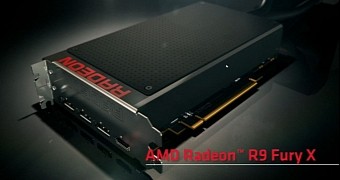
 14 DAY TRIAL //
14 DAY TRIAL // 